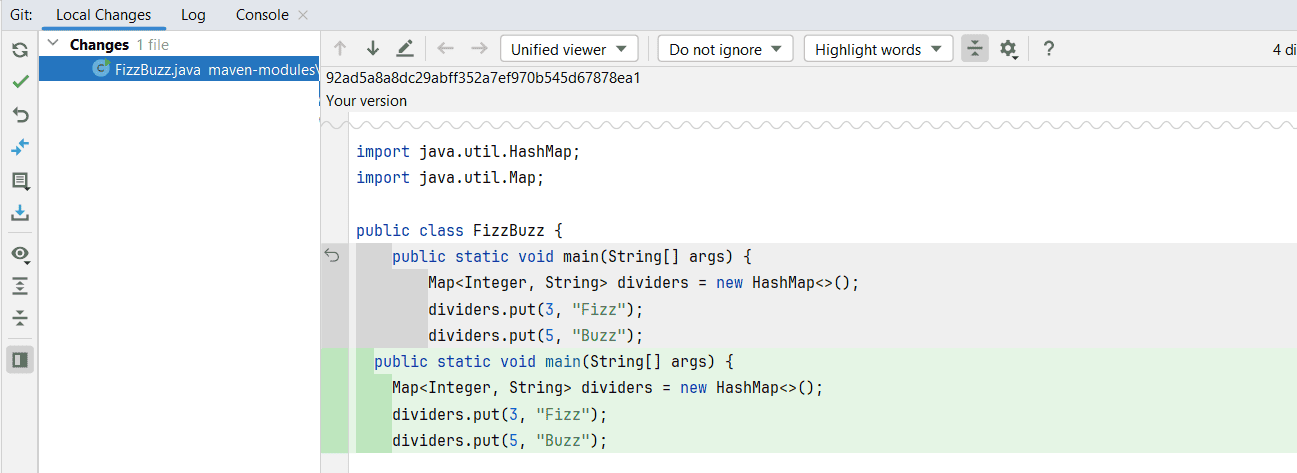1. 概述
本文将介绍 Maven Spotless Plugin 的使用方法,通过它来统一项目代码风格。首先我们会用最小配置分析源码并修复格式问题,然后逐步扩展配置实现自定义规则,最后将检查绑定到特定 Maven 构建阶段。
2. 快速上手
Maven Spotless Plugin 是一个在构建过程中自动格式化代码并强制执行代码规范的工具。使用 Spotless 非常简单,只需在 spotless-maven-plugin 中指定你偏好的代码格式即可。
在 pom.xml 中添加插件并配置使用 Google Java Style:
<plugin>
<groupId>com.diffplug.spotless</groupId>
<artifactId>spotless-maven-plugin</artifactId>
<version>2.43.0</version>
<configuration>
<java>
<googleJavaFormat/>
</java>
</configuration>
</plugin>
搞定!现在运行 mvn spotless:check,插件会自动扫描 Java 文件并检查格式是否符合规范。控制台会显示扫描文件数和违规数量:
注意:只要发现一处格式违规,构建就会失败。向下滚动日志能看到具体问题,比如这里代码用了制表符,而 Google 规范要求使用两个空格缩进:
执行 mvn spotless:apply 可自动修复所有违规。修复后对比远程分支的代码差异:
可以看到源码已被正确格式化,符合 Google Java 标准。
3. 自定义格式规则
前面我们用最小配置实现了基础格式检查,但通过 Eclipse Formatter Profile 可以定义更灵活的格式规则。这种 XML 配置文件兼容多种 IDE 和格式化插件。
在项目根目录创建 baeldung-style.xml:
<profiles version="21">
<profile kind="CodeFormatterProfile" name="baeldung-style" version="21">
<setting id="org.eclipse.jdt.core.formatter.tabulation.char" value="space"/>
<setting id="org.eclipse.jdt.core.formatter.use_tabs_only_for_leading_indentations" value="true"/>
<setting id="org.eclipse.jdt.core.formatter.indentation.size" value="4"/>
<!-- 其他配置... -->
<setting id="org.eclipse.jdt.core.formatter.enabling_tag" value="@formatter:on"/>
<setting id="org.eclipse.jdt.core.formatter.disabling_tag" value="@formatter:off"/>
</profile>
</profiles>
更新 pom.xml 使用自定义配置(移除
<plugin>
<groupId>com.diffplug.spotless</groupId>
<artifactId>spotless-maven-plugin</artifactId>
<version>2.43.0</version>
<configuration>
<java>
<eclipse>
<file>${project.basedir}/baeldung-style.xml</file>
</eclipse>
</java>
</configuration>
</plugin>
现在运行 mvn spotless:check 即可验证代码是否符合自定义规范。
4. 扩展功能
除了格式检查,Spotless 还能执行静态分析并自动优化代码。在指定代码风格后,可添加以下扩展步骤:
<java>
<eclipse>
<file>${project.basedir}/baeldung-style.xml</file>
</eclipse>
<licenseHeader>
<content>/* (C)$YEAR */</content>
</licenseHeader>
<importOrder/>
<removeUnusedImports />
<formatAnnotations />
</java>
执行 spotless:apply 时,每个步骤会处理特定规则:
✅
✅
✅
运行命令后,所有优化会自动应用:

5. 绑定 Maven 构建阶段
目前我们都是手动执行 spotless:check 和 spotless:apply,**其实可以将这些目标绑定到特定 Maven 阶段**。Maven 阶段是构建生命周期的预定义节点,按顺序执行任务。
例如将 spotless:check 绑定到 package 阶段(打包阶段):
<plugin>
<groupId>com.diffplug.spotless</groupId>
<artifactId>spotless-maven-plugin</artifactId>
<version>2.43.0</version>
<configuration>
<java>
<!-- 格式化规则和扩展步骤 -->
</java>
</configuration>
<executions>
<execution>
<goals>
<goal>check</goal>
</goals>
<phase>package</phase>
</execution>
</executions>
</plugin>
这样每次执行 mvn package 时会自动触发代码检查。如果代码不符合规范,构建会直接失败,强制团队保持代码风格一致。
6. 总结
本文介绍了 Maven Spotless Plugin 的核心功能:从基础的 Google Java 格式检查,到自定义 Eclipse 格式规则,再到扩展的静态分析优化,最后通过绑定 Maven 阶段实现自动化检查。合理使用这些功能,能有效提升团队代码质量和一致性。
完整代码示例可在 GitHub 获取。


